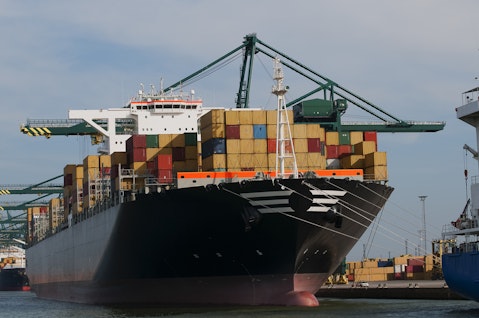GasLog Partners LP (NYSE:GLOP) Q4 2022 Earnings Call Transcript January 26, 2023
Operator: Good morning. My name is Olivia, and I will be your conference operator today. At this time, I would like to welcome everyone to the GasLog Partners Fourth Quarter 2022 Results Conference Call. All lines have been placed on mute to prevent any background noise. As a reminder, this conference call is being recorded. On today’s call are Paolo Enoizi, Chief Executive Officer; and Achilleas Tasioulas, Chief Financial Officer. And now, Robert Brinberg from Rose & Company will begin your conference.
Robert Brinberg: Good morning or good afternoon, and thank you for joining the GasLog Partners’ fourth quarter 2022 earnings conference call. For your convenience, this webcast and presentation are available on the Investor Relations section of our website, www.gaslogmlp.com, where a replay will also be available. If you are participating via webcast, please note that the slide presentation is user controlled and we encourage you to advance through the presentation as you are prompted to. Please now turn to Slide 2 of the presentation. Many of our remarks contain forward-looking statements. For factors that could cause actual results to differ materially from these forward-looking statements, please refer to our third — our fourth quarter earnings press release.
In addition, some of our remarks contain non-GAAP financial measures as defined by the SEC. A reconciliation of these measures is included in the appendix to this presentation. Paolo will now begin today’s call with a review of the Partnership’s fourth quarter and full year highlights and market update, following which, Achilleas will walk you through the Partnership’s financials. With that, I will now turn the call over to Paolo Enoizi, CEO of GasLog Partners.
Paolo Enoizi: Thank you, Rob, and welcome everyone to our fourth quarter conference call. Before I get started, I would like to acknowledge that as per yesterday’s press release, the Partnership received an unsolicited proposal from GasLog Ltd., which our Board and conflict committee are currently reviewing. This presentation, however, does not touch upon the proposal, as this process is currently underway. We therefore, deem it appropriate that no Q&A session is held today. Please turn to Slide 4 for GasLog Partners’ fourth quarter highlights. Thanks to increased LNG flow throughout the year, Europe managed to replace Russian gas, achieving seasonally high inventories and ensuring that Europe will be able to get through this winter.
In the process, energy prices and spot shipping rates increased to record highs. Both prices and rates softened during the fourth quarter, as warmer-than-average weather in Europe resulted in decreased consumption. Prices fell nearly 80% from their August peak, and inventories are currently nearly 20% above the seasonal average. Although the LNG shipping spot market has come off significantly, the Partnership managed to fix its remaining open days in the term market at attractive rates. This leaves the Partnership with 87% of days in 2023 fixed, while the remaining ones are heavily weighted towards a seasonally strong fourth quarter. The term market has remained tight, leading to the declaration of charter’s options for two of our vessels and a new charter fixture for GasLog Seattle, as I will discuss shortly.
Overall, our contracted revenue backlog rose to $729 million, an increase of 18% since our last update and approximately 30% compared to the fourth quarter of 2021. Our capital allocation strategy and disciplined use of cash has allowed us to continue working towards our gross debt to cap target, while our pref buyback have increased our free cash flow per unit by $0.11. We also de-risked our fleet through the well-timed direct sale and sale and leaseback transactions in 2022. Please turn to Slide 5. In this slide, we’ll focus on the impact that the Russian-Ukrainian conflict has had on the energy commodity market. You can see that monthly pipeline flow from Russia have fallen nearly 90% since the start of 2022. Despite this, and thanks to the flexibility of the LNG supply chain, Europe managed to fill its inventory to seasonally high levels.
Thankfully, competition from major importers was notably absent due to a combination of high LNG prices, moderate weather and continuing COVID restrictions in China. This has created two dynamics that are of interest. Firstly, higher LNG flows into Europe are likely to continue in 2023. Secondly, increased global demand for LNG has both exacerbated an overall scarcity of energy supply and, specifically, an LNG supply deficit, which is likely to remain until new import and export capacity comes online. In response to this, we’ve seen about 25 million tons of new project being sanctioned and expect this figure to double in 2023, creating additional demand for LNG carriers to match the robust newbuilding order book. Slide 6 focuses on the impact of these dynamics in the shipping market.
The spot market saw significant volatility in the last quarter of 2022, driven primarily by the conditions I discussed. The spot market peaked at nearly $450,000 per day, as congestions and floating storage heavily restricted availability of vessels, while charterers were mostly unwilling to sublet their vessels. Since rate peaked, above average temperature have reduced the constant need to fill inventories, resulting in falling LNG prices and easing on floating storage. Additionally, the continuing Freeport outage and persistent low exports from Nigeria have resulted in reduced LNG exports and increased the number of spot vessels available in the Atlantic. Increased volumes are balanced with the shorter trips, reflecting the higher flow from U.S. to Europe rather than Asia to keep ton-mile demand flat in 2022.

itsajoop/Shutterstock.com
Regardless, the term market remains strong, thanks to the charter’s continuing interest for multiyear coverage, that can only be met with independently-owned vessels, while the number of uncommitted vessels keeps falling. In the next slide, you can see more details on the charters I reference earlier, namely the two extensions and the one new charter, having a combined $167 million of EBITDA. The extensions also have reaffirmed the attitude of charterers to focus on term business. As mentioned in our previous calls, the work with Venice Energy has progressed. And although still under negotiation, we have agreed in principle that the Partnership will convert one of its 145,000 cubic steam LNG carriers to an FSRU, which will be chartered to Venice Energy as effective returns.
Further information on the project FID are expected in mid-2023. Such conversion is expected to cost in excess of $100 million and take between eight to 10 months. Finally, in Slide 8, we would like to give an update on environmental-related regulations affecting our business. There are several regulatory bodies that have issued and now developing dedicated regulations aimed at decarbonizing worldwide shipping. Late 2022, the European Union has moved on two fronts under the Fit For 55 umbrella: (ph) the entry of shipping into the European Emission Trading Scheme, EU ETS, and launching the FuelEU in order to promote a transition to green fuel in a stepped approach. These regulations will gradually enter into force in the next years, and add to the IMO framework in order to drive the industry net zero targets.
As we seek further clarifications on the application of such rules, the Partnership is developing dedicated plans to improve ships’ efficiency and reduce emission, as well as cooperating with our customers and investing in digital tools to improve the efficient use of our ships. Further updates in the months to come and in our 2022 ESG report. Before I hand over to Achilleas, I’m delighted to report that the Partnership vessels had another year of particularly good safety score in 2022 with zero LTIs, achieving the ever-needed Goal 0.
Achilleas Tasioulas: Thank you, Paolo. Turning to Slide 10 and the Partnership’s financial results for the fourth quarter of 2022. Revenues for the fourth quarter were $105 million, a 19% increase from the fourth quarter of 2021. This was primarily due to a net increase in revenues from our vessels operating in the spot and short-term markets in the fourth quarter of 2022 in line with the continued strength of the LNG shipping spot and short-term markets. This increase came despite a decrease in available days due to the sale of the Methane Shirley Elisabeth in the third quarter of 2022. Adjusted EBITDA was $81 million, an increase of approximately $17 million or 26% from the fourth quarter of 2021, primarily due to a year-over-year increase in revenues, as mentioned earlier.
Operating expenses were decreased by $0.9 million, mostly due to the favorable movement of the EUR/USD exchange rate in the fourth quarter of 2022, as well as the sale of the Methane Shirley Elisabeth in the third quarter of 2022, partially offset by the in-house management of the Solaris after her redelivery into our managed fleet on quarter two 2022. Finally, our adjusted earnings was $0.74 per unit, which increased by 64% compared to the fourth quarter of 2021. Overall, we are pleased with our performance in this quarter, as we continued rechartering our fleet at healthy rates with improved visibility on our 2023 cash flows. Turning to Slide 11 and a look at our cost base. Our daily operating expenses per vessel were $13,974 in the fourth quarter, a decrease of $721 per day compared to the fourth quarter of 2021 due to the factors I just described earlier.
General and administrative expenses were $4.2 million in the fourth quarter of 2022, an increase of approximately $0.7 million from the fourth quarter of 2021. Daily general and administrative expenses increased to $3,240 per vessel per day in the fourth quarter of 2022 from $2,543 per vessel per day in the fourth quarter of 2021 due to an increase in the administrative service fees for our fleet, which was partially offset by a decrease in the size of our fleet following the sale of the Methane Shirley Elisabeth in the third quarter of 2022. As a reminder, the changes in the vessel management, commercial management and administrative service fees compared to the prior year are in line with our commentary in the previous quarters and are disclosed in detail in our 20-F.
Our results were also impacted by a $6.3 million increase in interest expense due to an increase in the base interest rate, LIBOR or SOFR, compared to the fourth quarter of 2021, partially offset by the deleveraging achieved during the last 12 months. For 2023, we expect our unit operating expenses to average approximately $13,850 per vessel per day, with (ph) operating expenses materially impacted by the foreign exchange movement. General and administrative expenses are expected to average approximately $3,600 per vessel per day in 2023. Also, we have four vessels that will undergo scheduled dry-dockings in 2023, which will result in approximately 30 of higher revenue days per vessel and the total estimated cost of $15.5 million, including cost for ballast water treatment systems.
The impact of scheduled (ph) days is factored into Slide 14, to be discussed shortly. Slide 12 illustrates the progress the Partnership has continued to make in its preference unit repurchase program. During the fourth quarter, we repurchased an aggregate of $10.5 million of our preference units in the open market. Since the program was initiated in August 2021, the Partnership has repurchased approximately $68 million in preference units in aggregate at an average price close to $25.00 per unit (ph). These repurchases have reduced preference unit distribution by approximately $5.7 million or $0.11 per common unit on an annualized basis based on the number of preference units outstanding as of today. We expect to continue opportunistically repurchasing preference units in the open market as conditions dictate and there are $87.4 million in Series B preference units outstanding as of today, which are callable and from mid-March 2023 and onwards at the Partnership’s option.
Slide 13 shows the progress we have made towards our leverage targets, which we first introduced in the first quarter of 2021. We have made good progress on these goals despite the impairment charges we took in 2022 in connection with the book value of our steam vessels. During the fourth quarter of 2022, we repaid $21.7 million of debt and leases on scheduled amortization and $116 million in the fourth quarter of 2022. In addition, we repaid $32.2 million of debt outstanding in relation to the sale of the Methane Shirley Elisabeth in quarter three 2022 and $32.9 of debt outstanding in relation to the sale and leaseback of the Methane Heather Sally in quarter four 2022. As a result, our gross debt/total capitalization, one of the two leveraged targets we have set, has been reduced from 54% as of the end of the fourth quarter of 2021 to 49% as of the end of this past quarter.
Furthermore, our net debt to trailing 12 months EBITDA has been reduced from 4.4x to 2.8x, which is currently below our long-term target. Net debt to EBITDA has, of course, been positively impacted by the Partnership’s strong performance in 2022 as well as the increase in the cash and cash equivalents in our balance sheet. It is important to remember that our net debt to EBITDA may fluctuate based on our future operating results and the deployment of cash in the execution of our capital allocation strategy. We expect to continue reducing our gross debt to capitalization in 2023 with a scheduled retirement of approximately $112 million of scheduled debt and lease principal payments in aggregate. Reducing debt balances and making opportunistic repurchases of preference units will further reduce the Partnership’s cash flow all-in break-even levels over time and increases our future free cash flow generation potential, enhancing the Partnership’s equity value.
Slide 14 shows our contracted revenues by quarter in 2023. As you can see from the chart on the left, we have managed our exposure to the spot market over the next 12 months, while still maintaining exposure to the second — seasonally strong fourth quarter in 2023. This provides significant downside protection in 2023. Every $10,000 per day increase in TCE on our open days above our operating break-even rates will increase our adjusted EBITDA by approximately $6.7 million on full year basis. With that, I will turn it over to Paolo for closing remarks.
Paolo Enoizi: Thank you, Achilleas. Turning to Slide 16, and in summary, energy security continues to drive market volatility, demand for LNG supply and supports new FID for additional capacity. The LNG shipping market has benefited from such dynamics and currently maintain strong term business level even in the phase of potentially challenging ton-mile development between Europe and Far East. Partnership has capitalized well on the strong LNG market, securing lucrative fixture throughout 2022 and the exercise of two option charter periods for our vessels. Our disciplined approach and focus on deleveraging has strengthened the Partnership balance sheet, delivering tangible value to our unitholders as well as enable us to identify growth opportunities and effective market returns.
Finally, the Partnership continues to benefit from the favorable shipping market in 2023 and we’re diligently executing on our strategy to meet our capital structure targets. Thank you to everyone today for listening and for your continued interest in GasLog Partners. Stay safe. And if you have any question, please contact the Investor Relationship team.
See also Top AI Healthcare Stocks to Buy and 10 Penny Stocks that will Make You A Millionaire.
Q&A Session
Follow Gaslog Partners Lp (NYSE:GLOP)
Follow Gaslog Partners Lp (NYSE:GLOP)
Achilleas Tasioulas: Thank you.
Paolo Enoizi: Thank you.
Operator: Ladies and gentlemen, this concludes today’s conference call. Thank you for participating. You may now disconnect.
End of Q&A:



